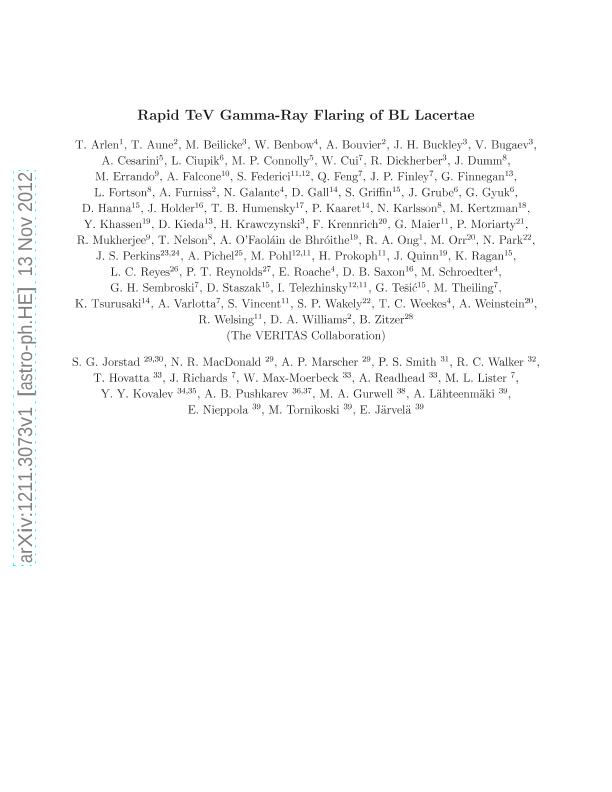Artículo
Rapid TeV Gamma-Ray Flaring of BL Lacertae
Arlen, T.; Aune, T.; Beilicke, M.; Benbow, W.; Bouvier, A.; Buckley, J. H.; Bugaev, V. ; Cesarini, A.
; Cesarini, A. ; Ciupik, L.
; Ciupik, L. ; Connolly, M. P.; Cui, W.; Dickherber, R.; Dumm, J.; Errando, M.; Falcone, A.
; Connolly, M. P.; Cui, W.; Dickherber, R.; Dumm, J.; Errando, M.; Falcone, A. ; Federici, S.
; Federici, S. ; Feng, Q.
; Feng, Q. ; Finley, J. P.
; Finley, J. P. ; Finnegan, G.
; Finnegan, G. ; Fortson, L.
; Fortson, L. ; Furniss, A.
; Furniss, A. ; Galante, N.
; Galante, N. ; Gall, D.
; Gall, D. ; Griffin, S.
; Griffin, S. ; Grube, J.
; Grube, J. ; Gyuk, G.
; Gyuk, G. ; Hanna, D.
; Hanna, D. ; Holder, J.
; Holder, J. ; Humensky, T. B.
; Humensky, T. B. ; Pichel, Ana Carolina
; Pichel, Ana Carolina ; The VERITAS Collaboration
; The VERITAS Collaboration
 ; Cesarini, A.
; Cesarini, A. ; Ciupik, L.
; Ciupik, L. ; Connolly, M. P.; Cui, W.; Dickherber, R.; Dumm, J.; Errando, M.; Falcone, A.
; Connolly, M. P.; Cui, W.; Dickherber, R.; Dumm, J.; Errando, M.; Falcone, A. ; Federici, S.
; Federici, S. ; Feng, Q.
; Feng, Q. ; Finley, J. P.
; Finley, J. P. ; Finnegan, G.
; Finnegan, G. ; Fortson, L.
; Fortson, L. ; Furniss, A.
; Furniss, A. ; Galante, N.
; Galante, N. ; Gall, D.
; Gall, D. ; Griffin, S.
; Griffin, S. ; Grube, J.
; Grube, J. ; Gyuk, G.
; Gyuk, G. ; Hanna, D.
; Hanna, D. ; Holder, J.
; Holder, J. ; Humensky, T. B.
; Humensky, T. B. ; Pichel, Ana Carolina
; Pichel, Ana Carolina ; The VERITAS Collaboration
; The VERITAS Collaboration
Fecha de publicación:
10/01/2013
Editorial:
Iop Publishing
Revista:
Astrophysical Journal
ISSN:
0004-637X
Idioma:
Inglés
Tipo de recurso:
Artículo publicado
Clasificación temática:
Resumen
We report on the detection of a very rapid TeV gamma-ray flare from BL Lacertae on 2011 June 28 with the Very Energetic Radiation Imaging Telescope Array System (VERITAS). The flaring activity was observed during a 34.6 minute exposure, when the integral flux above 200 GeV reached (3.4 ± 0.6) × 10^-6 photons m^-2 s^-1, roughly 125% of the Crab Nebula flux measured by VERITAS. The light curve indicates that the observations missed the rising phase of the flare but covered a significant portion of the decaying phase. The exponential decay time was determined to be 13 ± 4 minutes, making it one of the most rapid gamma-ray flares seen from a TeV blazar. The gamma-ray spectrum of BL Lacertae during the flare was soft, with a photon index of 3.6 ± 0.4, which is in agreement with the measurement made previously by MAGIC in a lower flaring state. Contemporaneous radio observations of the source with the Very Long Baseline Array revealed the emergence of a new, superluminal component from the core around the time of the TeV gamma-ray flare, accompanied by changes in the optical polarization angle. Changes in flux also appear to have occurred at optical, UV, and GeV gamma-ray wavelengths at the time of the flare, although they are difficult to quantify precisely due to sparse coverage. A strong flare was seen at radio wavelengths roughly four months later, which might be related to the gamma-ray flaring activities. We discuss the implications of these multiwavelength results.
Archivos asociados
Licencia
Identificadores
Colecciones
Articulos(IAFE)
Articulos de INST.DE ASTRONOMIA Y FISICA DEL ESPACIO(I)
Articulos de INST.DE ASTRONOMIA Y FISICA DEL ESPACIO(I)
Citación
Arlen, T.; Aune, T.; Beilicke, M.; Benbow, W.; Bouvier, A.; et al.; Rapid TeV Gamma-Ray Flaring of BL Lacertae; Iop Publishing; Astrophysical Journal; 762; 10-1-2013; 92, 1-13
Compartir
Altmétricas



